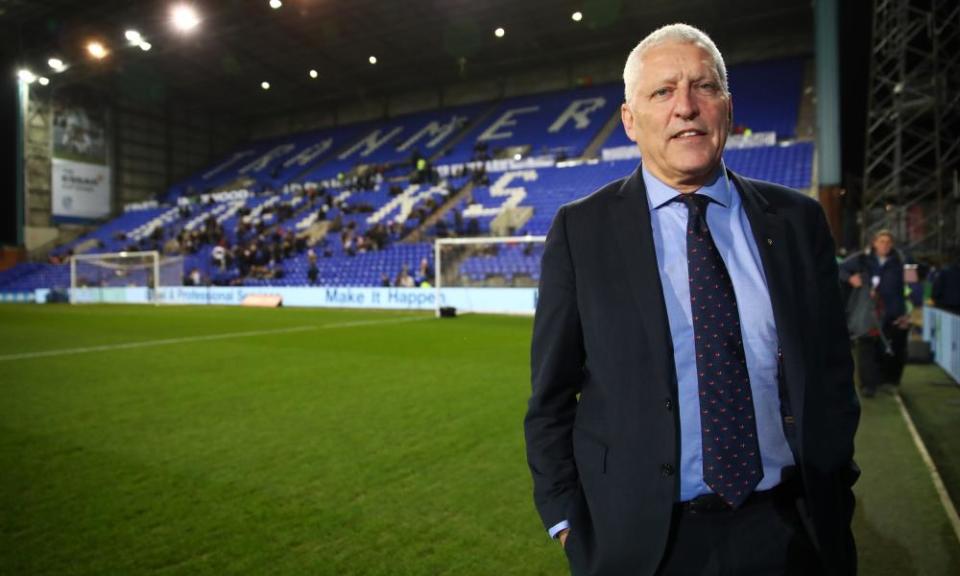Fans' return will not be cash bonanza many EFL clubs are hoping for

When the prime minister confirmed plans to restore supporters to stadiums from next month, there was excitement among fans, millions of whom have been stuck watching from the sofa for eight months. They have longed for the smells, sounds and even the moans and groans of a matchday, but for clubs bruised by the pandemic, this is merely the first step on the road to recovery. The timely cheer is tempered by the sobering reality that, for most clubs, the cost of staging matches with a smattering of supporters means further losses.
Related: Fans' long-awaited return to stadiums could be hit by shortage of stewards
Many clubs were pleasantly surprised by the timing of the announcement and are preparing to welcome as many as 4,000 in tier 1 areas, due to be announced on Thursday. Financially such numbers will not make a splash, certainly not in the Premier League pond, but the sight of fans on the concourses will be one to cherish regardless. “We will do this because we feel it’s the right thing to do so as to [get to] where we want to be and, secondly, we absolutely owe it to the fans to bring them back at the earliest opportunity when it’s safe,” says Paul Barber, the Brighton chief executive.
The prospect of fans returning is seen by Barber as “a small step towards normality”. The EFL chair, Rick Parry, described it as a “lifeline” for smaller clubs but there is no hiding the cold reality facing many teams. Several Championship clubs said hosting 2,000 fans would be a loss-making exercise and one suggested a crowd of 4,000 means “you might be able to wipe your face”. One League One club with more than 10,000 season-ticket holders pointed out that the return of some fans would at least reduce the need for universal rebates.

Many hold concerns over immediate cashflow, with one League Two club estimating their stewarding and security costs will soar to about £15,000 a home game, compared with £1,300 behind closed doors. For the majority of clubs the return of fans does not equate to fresh cash. “I think it will make little difference for League One and League Two clubs other than being directionally positive,” says Mark Palios, the Tranmere chairman. “If we come out in tier 2, we will be allowed 2,000 fans but we have 3,000 season-ticket holders who have already paid money. In tier 2, it would probably cost us £10,000 to put games on that we wouldn’t have to do in tier 3 [where no fans are permitted].”
Brighton, who are losing more than £1m for every home match behind closed doors, expect to be able to serve food and drink when supporters return. For lower-league clubs, “secondary spend” is critical. “For us to make revenue on matchdays, we rely on supporters buying burgers, beers, programmes, etc,” says the Bradford director Ryan Sparks. “Undoubtedly all of our costs are going to increase and we certainly won’t be making any money on a matchday. For some clubs it will be hugely detrimental.”
The Premier League, together with the Department for Digital, Culture, Media and Sport and Stig (the Sports Technology and Innovation Group), continue to build a code of conduct detailing how matchday will work, such as social-distancing measures and where masks must be worn. Barber hopes fans will be allowed to “sing and shout” as normal and that clubs “don’t become the nanny state and say you can’t do this, you can’t do that”.
He wants to convince the government it is safe to bring in larger crowds. He says: “If we can use it as a proof of concept as we did with the test event [in August, when Brighton hosted 2,500 fans] then that gives more power to our arm when it comes to more talks with government over larger crowds … This is a positive step but it can only be a first step and we need to understand what the roadmap is to getting bigger crowds back in our stadiums sooner rather than later.”
Related: Nicklas Bendtner, Martin Keown and the ubiquity of pink football boots
In the meantime, with November payday fast approaching, lower-league clubs remain in desperate need of the £50m bailout agreed with the top flight. “I think that absolutely has to take place to make the difference clubs need,” says Andrew Parkinson, the Plymouth Argyle chief executive. “The return of fans will not fill the financial hole we have. We have been asked, along with other EFL clubs, to forecast our financials until the end of the season, and I think that will go some way to supporting that claim that the full £50m would be needed in order for clubs to get through the next months.”
Palios, meanwhile, questions the sporting integrity of a competition in which some teams will reap the benefit of having supporters and others will go without. “One of our difficulties with the pandemic is we lose the home advantage. If we play at someone else’s ground and they are tier 1 and they have 4,000 fans allowed in, that makes a bit of a difference at this level but I think that is one of those things we just have to accept. This is a relatively positive move forwards.”

 Yahoo Sport
Yahoo Sport 





































